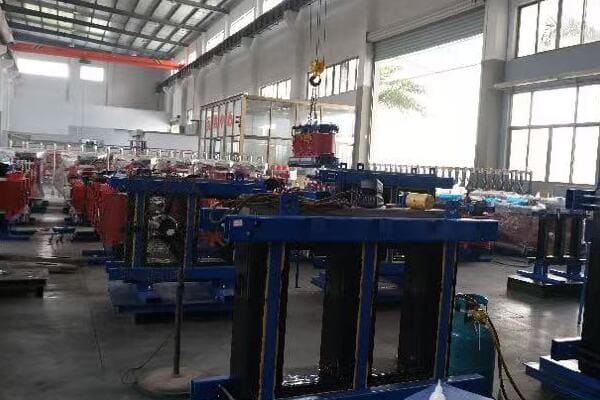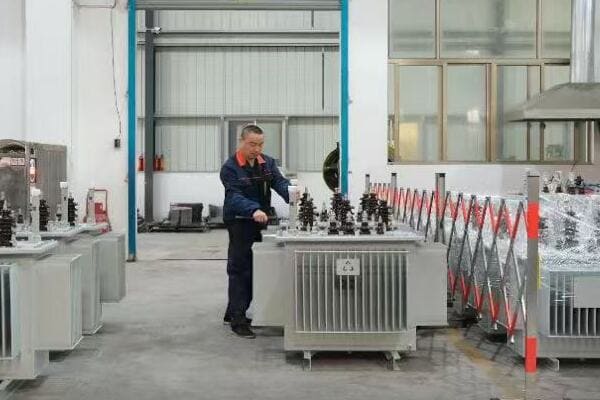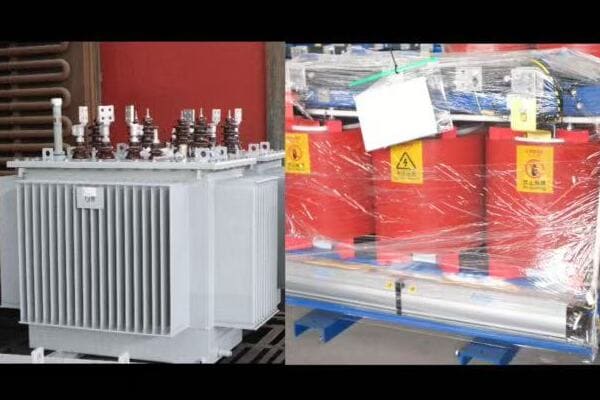Dry Type vs Oil Filled Transformer: Which is Best for Your Project?
Are you struggling to choose between a dry type and an oil filled transformer for your next project? You’re not alone. This decision can significantly impact your system’s efficiency, safety, and long-term costs. But don’t worry, I’m here to help you make an informed choice.
Dry type transformers use air for cooling and are ideal for indoor installations due to their fire safety, while oil filled transformers use oil for cooling and insulation, offering higher efficiency and capacity. The choice depends on factors like installation location, maintenance requirements, environmental conditions, and project budget.

As someone who has worked with both types of transformers for years, I’ve seen their strengths and weaknesses in various applications. In this article, I’ll guide you through the key differences and help you determine which type is best for your specific needs. Let’s dive into the world of transformers and uncover the secrets to making the right choice.
What is a Dry Type Transformer: Understanding the Air-Cooled Giant?
Have you ever wondered how transformers can operate safely inside buildings without the risk of oil leaks or fires? The answer lies in dry type transformers. But what exactly are they, and how do they work?
A dry type transformer is an electrical transformer that uses air as its cooling medium instead of oil. It typically uses high-temperature insulation materials like epoxy resin to encapsulate its windings. These transformers are ideal for indoor installations, especially in areas where fire safety is a primary concern.

I remember the first time I installed a dry type transformer in a high-rise office building. The client was amazed at how we could place such a powerful electrical component right in the basement without worrying about fire hazards. Let’s explore the ins and outs of these air-cooled marvels.
Types of Dry Type Transformers
Dry type transformers come in several varieties, each with its own advantages:
-
Vacuum Pressure Impregnated (VPI) Transformers:
- Windings are impregnated with varnish under vacuum.
- Offers excellent moisture resistance.
- I once used a VPI transformer in a humid coastal environment, and it performed flawlessly.
-
Vacuum Pressure Encapsulated (VPE) Transformers:
- Windings are fully encapsulated in epoxy resin.
- Provides superior protection against environmental factors.
- Ideal for harsh industrial environments.
-
Cast Resin Transformers:
- Windings are cast in epoxy resin under vacuum.
- Offers excellent fire resistance and low noise operation.
- Perfect for hospitals and educational institutions.
-
Open Wound Transformers:
- Simplest design with exposed windings.
- Cost-effective but limited in application due to lower protection.
Here’s a quick comparison of these types:
| Type | Environmental Protection | Cost | Typical Applications |
|---|---|---|---|
| VPI | Good | Moderate | Commercial buildings, Light industry |
| VPE | Excellent | High | Heavy industry, Offshore platforms |
| Cast Resin | Excellent | High | Hospitals, Schools, High-rise buildings |
| Open Wound | Limited | Low | Indoor substations, Low-risk areas |
Advantages of Dry Type Transformers
Dry type transformers offer several benefits:
-
Fire Safety:
- Minimal fire risk due to absence of flammable oil.
- I once recommended a dry type transformer for a museum, where fire safety was paramount.
-
Environmental Friendliness:
- No risk of oil leaks or spills.
- Easier to dispose of at end of life.
-
Low Maintenance:
- No need for regular oil checks or replacements.
- Reduced maintenance costs over time.
-
Indoor Installation:
- Can be installed close to the load center.
- Saves space and reduces power losses in long cables.
-
Overload Capacity:
- Can handle short-term overloads better than oil filled types.
Limitations of Dry Type Transformers
However, they do have some drawbacks:
-
Limited Capacity:
- Typically available up to 35kV and 40MVA.
- For higher ratings, oil filled transformers are usually preferred.
-
Higher Initial Cost:
- Generally more expensive upfront than oil filled transformers.
- However, this can be offset by lower maintenance costs.
-
Noise:
- Can be noisier than oil filled types.
- I once had to design a special enclosure to reduce noise in a library installation.
-
Sensitivity to Harsh Environments:
- May require special enclosures in very dusty or humid conditions.
Applications of Dry Type Transformers
Dry type transformers are widely used in:
-
Commercial Buildings:
- Office complexes, shopping malls, hotels.
-
Industrial Facilities:
- Factories, processing plants, data centers.
-
Institutional Buildings:
- Schools, hospitals, government buildings.
-
Renewable Energy:
- Wind farms, solar power plants.
-
Transportation:
- Airports, subway stations, electric vehicle charging stations.
Remember, choosing a dry type transformer isn’t just about avoiding oil. It’s about selecting the right solution for your specific environment and safety requirements. In my experience, dry type transformers shine in indoor applications where fire safety and environmental concerns are top priorities.
What is an Oil Filled Transformer: Diving into the Liquid-Cooled Powerhouse?
Have you ever seen those large, cylindrical tanks at electrical substations and wondered what’s inside? Chances are, you’re looking at an oil filled transformer. But what exactly are they, and why are they so common in our power distribution systems?
An oil filled transformer, also known as a liquid immersed transformer, is an electrical transformer that uses oil for both cooling and insulation. The core and windings are immersed in specially treated mineral oil, which dissipates heat and provides excellent electrical insulation. These transformers are capable of handling higher voltages and power ratings than dry type transformers.

I remember the first time I worked on a large oil filled transformer at a power substation. The sheer size and complexity of the unit were impressive, but what really struck me was its efficiency in handling massive amounts of power. Let’s explore these liquid-cooled powerhouses in detail.
Types of Oil Filled Transformers
Oil filled transformers come in various types:
-
Distribution Transformers:
- Used in the final voltage transformation on the distribution grid.
- Typically range from 5 kVA to 2500 kVA.
- I once installed these in a new residential development, bringing power to hundreds of homes.
-
Power Transformers:
- Used in transmission networks and for large power users.
- Ratings can go up to several hundred MVA.
- These giants are the backbone of our power transmission system.
-
Pad-Mounted Transformers:
- Ground-mounted units often seen in residential areas.
- Combine the transformer and switchgear in one enclosure.
-
Pole-Mounted Transformers:
- Smaller units mounted on utility poles.
- Common in rural power distribution.
Here’s a quick comparison:
| Type | Typical Capacity Range | Primary Application | Installation |
|---|---|---|---|
| Distribution | 5 kVA – 2500 kVA | Local power distribution | Ground/Pole |
| Power | Up to 1000 MVA | Power transmission | Substation |
| Pad-Mounted | 75 kVA – 5000 kVA | Urban/Suburban distribution | Ground |
| Pole-Mounted | 5 kVA – 167 kVA | Rural distribution | Utility Pole |
Advantages of Oil Filled Transformers
Oil filled transformers offer several benefits:
-
Excellent Cooling:
- Oil is an efficient cooling medium, allowing for higher power ratings.
- I’ve seen these transformers handle massive overloads during peak demand periods.
-
Higher Efficiency:
- Generally more efficient than dry type, especially at higher ratings.
- This translates to lower operating costs over time.
-
Longer Lifespan:
- With proper maintenance, can last 30-40 years or more.
- I’ve worked on transformers older than me that were still going strong!
-
Higher Voltage Capabilities:
- Can handle voltages up to 765 kV or higher.
- Essential for long-distance power transmission.
-
Cost-Effective for High Ratings:
- More economical than dry type for high power applications.
Limitations of Oil Filled Transformers
However, they do have some drawbacks:
-
Fire Risk:
- Transformer oil is flammable, posing a potential fire hazard.
- Requires additional fire safety measures.
-
Environmental Concerns:
- Risk of oil leaks and spills.
- Proper containment and disposal procedures are crucial.
-
Maintenance Requirements:
- Regular oil testing and potential oil replacement needed.
- I once had to coordinate an emergency oil change in the middle of a heatwave!
-
Weight and Size:
- Generally heavier and larger than equivalent dry type units.
- Can be a challenge in space-constrained installations.
Applications of Oil Filled Transformers
Oil filled transformers are widely used in:
-
Power Generation Plants:
- Step-up transformers to increase voltage for transmission.
-
Transmission Substations:
- Large power transformers for long-distance power transmission.
-
Distribution Networks:
- Bringing power from substations to end-users.
-
Industrial Facilities:
- Large factories, mining operations, steel plants.
-
Renewable Energy:
- Wind farms and large solar installations.
Remember, while oil filled transformers require more maintenance and have some environmental considerations, they’re often the go-to choice for high power applications and outdoor installations. Their efficiency and ability to handle high voltages make them indispensable in our power distribution systems.
Dry Type vs Oil Filled Transformer: Key Differences You Need to Know?
Have you ever found yourself staring at transformer specifications, feeling like you’re trying to compare apples and oranges? You’re not alone. The choice between dry type and oil filled transformers can be daunting, but understanding their key differences is crucial for making the right decision for your project.
Dry type and oil filled transformers differ in their cooling methods, maintenance requirements, fire safety, efficiency, and suitable applications. Dry types use air for cooling and are safer for indoor use, while oil filled types use oil for cooling and insulation, offering higher efficiency and capacity but requiring more maintenance and safety precautions.

I’ve been in situations where choosing the wrong type of transformer could have led to disastrous consequences. Let’s break down the key differences to help you make an informed decision.
Cooling and Insulation: Air vs Oil
The most fundamental difference lies in their cooling and insulation methods:
-
Dry Type Transformers:
- Use air for cooling.
- Insulation typically consists of high-temperature materials like epoxy resin.
- I once installed a dry type transformer in a high-rise building where oil wasn’t an option due to fire regulations.
-
Oil Filled Transformers:
- Use oil for both cooling and insulation.
- The oil acts as a heat dissipator and provides excellent electrical insulation.
- In a power substation project, we used oil filled transformers for their superior cooling efficiency under high loads.
Fire Safety and Environmental Considerations
Safety and environmental impact are crucial factors:
-
Dry Type Transformers:
- Lower fire risk due to absence of flammable oil.
- Environmentally friendly with no risk of oil leaks.
- Ideal for indoor installations and environmentally sensitive areas.
-
Oil Filled Transformers:
- Higher fire risk due to flammable oil.
- Potential environmental hazard if oil leaks occur.
- Require additional fire safety measures and containment systems.
I once had to replace an oil filled transformer with a dry type in a hospital renovation project due to stricter fire safety regulations.
Efficiency and Power Capacity
Performance characteristics vary significantly:
-
Dry Type Transformers:
- Generally less efficient, especially at higher ratings.
- Typically available up to 35kV and 40MVA.
- Better suited for lower to medium power applications.
-
Oil Filled Transformers:
- More efficient, especially at higher ratings.
- Can handle voltages up to 765kV or higher.
- Ideal for high power and long-distance transmission applications.
Here’s a quick efficiency comparison:
| Rating | Dry Type Efficiency | Oil Filled Efficiency |
|---|---|---|
| 500 kVA | ~98% | ~98.5% |
| 2000 kVA | ~98.5% | ~99% |
| 10 MVA | ~99% | ~99.5% |
Maintenance Requirements
Maintenance needs differ significantly:
-
Dry Type Transformers:
- Lower maintenance requirements.
- No oil to monitor or replace.
- Periodic cleaning and inspection usually sufficient.
-
Oil Filled Transformers:
- Higher maintenance needs.
- Regular oil testing and potential oil replacement required.
- More complex maintenance procedures.
I once managed a facility where switching from oil filled to dry type transformers reduced annual maintenance costs by 30%.
Installation and Space Requirements
Location and space considerations are important:
-
Dry Type Transformers:
- Can be installed indoors, close to the load.
- Generally smaller and lighter.
- Ideal for space-constrained environments.
-
Oil Filled Transformers:
- Typically installed outdoors or in dedicated electrical rooms.
- Larger and heavier.
- Require more space and stronger foundations.
Noise Levels
Noise can be a significant factor in some installations:
-
Dry Type Transformers:
- Generally noisier due to core vibrations.
- Noise levels can be an issue in quiet environments.
-
Oil Filled Transformers:
- Usually quieter as oil helps dampen vibrations.
- Better suited for noise-sensitive applications.
I once had to design a special enclosure for a dry type transformer in a library to reduce noise levels.
Cost Considerations
Initial and long-term costs vary:
-
Dry Type Transformers:
- Higher initial cost, especially at lower ratings.
- Lower long-term maintenance costs.
-
Oil Filled Transformers:
- Lower initial cost, especially at higher ratings.
- Higher long-term maintenance costs.
Application Suitability
Different types suit different applications:
-
Dry Type Transformers:
- Ideal for indoor installations: office buildings, hospitals, schools.
- Good for areas with high fire safety requirements.
- Suitable for environments where oil leaks could be catastrophic.
-
Oil Filled Transformers:
- Perfect for outdoor substations and power transmission.
- Suitable for high power industrial applications.
- Ideal for harsh environments where the oil provides protection against moisture and contaminants.
Choosing between dry type and oil filled transformers isn’t just about technical specifications. It’s about understanding your specific needs, environment, and long-term operational requirements. In my experience, there’s no one-size-fits-all solution. The right choice depends on a careful evaluation of all these factors in the context of your unique project requirements.
Conclusion
Choosing between dry type and oil filled transformers depends on various factors including installation location, power requirements, maintenance capabilities, and environmental considerations. Dry type transformers excel in indoor and fire-sensitive applications, while oil filled transformers are superior for high power and outdoor installations. Carefully evaluate your specific needs to make the best choice for your project.
Free CHBEB Transformer Catalog Download
Get the full range of CHBEB transformers in one catalog.
Includes oil-immersed, dry-type, pad-mounted, and custom solutions.
Quick Message
Request A free quote
We'd like to work with you
- +86 15558785111
- [email protected]
- +86 15558785111
What We Do
CHINA BEI ER BIAN (CHBEB) GROUP, with 218 million in registered capital, originated from Beijing Beierbian Transformer Group. Headquartered in Beijing for R&D, it operates major production bases in Nanjing and Yueqing, producing high-quality products.
Latest Product
address
BeiJing
No 3,RongJing East Road,BeiJing Economic Technological Development Area,BeiJing,China
JiangSu
No 7️Xiangfeng Road,Jiangning,NanJing,JiangSu,China
WenZhou
No.211, Wei 16 Road, Industrial Zone, Yueqing, Wenzhou, Zhejiang, China.
XiangYang Industrial Zone ,YueQing,WenZhou,ZheJiang,China
contact us
- [email protected]
- +86 13057780111
- +86 13057780111
- +86 15558785111
Copyright © Bei Er Bian Group


